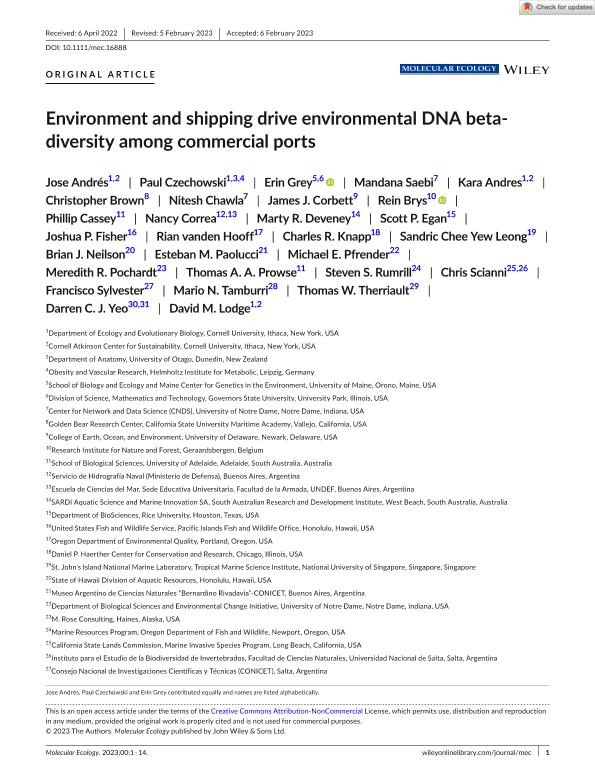Artículo
Environment and shipping drive environmental DNA beta-diversity among commercial ports
Andrés, Jose; Czechowski, Paul; Grey, Erin; Saebi, Mandana; Andres, Kara; Brown, Christopher; Chawla, Nitesh; Corbett, James J.; Brys, Rein; Cassey, Phillip; Correa, Nancy; Deveney, Marty R.; Egan, Scott P.; Fisher, Joshua P.; vanden Hooff, Rian; Knapp, Charles R.; Leong, Sandric Chee Yew; Neilson, Brian J.; Paolucci, Esteban Marcelo ; Pfrender, Michael E.; Pochardt, Meredith R.; Prowse, Thomas A. A.; Rumrill, Steven S.; Scianni, Chris; Sylvester, Francisco
; Pfrender, Michael E.; Pochardt, Meredith R.; Prowse, Thomas A. A.; Rumrill, Steven S.; Scianni, Chris; Sylvester, Francisco ; Tamburri, Mario N.; Therriault, Thomas W.; Yeo, Darren C. J.; Lodge, David M.
; Tamburri, Mario N.; Therriault, Thomas W.; Yeo, Darren C. J.; Lodge, David M.
 ; Pfrender, Michael E.; Pochardt, Meredith R.; Prowse, Thomas A. A.; Rumrill, Steven S.; Scianni, Chris; Sylvester, Francisco
; Pfrender, Michael E.; Pochardt, Meredith R.; Prowse, Thomas A. A.; Rumrill, Steven S.; Scianni, Chris; Sylvester, Francisco ; Tamburri, Mario N.; Therriault, Thomas W.; Yeo, Darren C. J.; Lodge, David M.
; Tamburri, Mario N.; Therriault, Thomas W.; Yeo, Darren C. J.; Lodge, David M.
Fecha de publicación:
12/2023
Editorial:
Wiley Blackwell Publishing, Inc
Revista:
Molecular Ecology
ISSN:
0962-1083
Idioma:
Inglés
Tipo de recurso:
Artículo publicado
Clasificación temática:
Resumen
The spread of nonindigenous species by shipping is a large and growing global problem that harms coastal ecosystems and economies and may blur coastal biogeographical patterns. This study coupled eukaryotic environmental DNA (eDNA) metabarcoding with dissimilarity regression to test the hypothesis that ship-borne species spread homogenizes port communities. We first collected and metabarcoded water samples from ports in Europe, Asia, Australia and the Americas. We then calculated community dissimilarities between port pairs and tested for effects of environmental dissimilarity, biogeographical region and four alternative measures of ship-borne species transport risk. We predicted that higher shipping between ports would decrease community dissimilarity, that the effect of shipping would be small compared to that of environment dissimilarity and shared biogeography, and that more complex shipping risk metrics (which account for ballast water and stepping-stone spread) would perform better. Consistent with our hypotheses, community dissimilarities increased significantly with environmental dissimilarity and, to a lesser extent, decreased with ship-borne species transport risks, particularly if the ports had similar environments and stepping-stone risks were considered. Unexpectedly, we found no clear effect of shared biogeography, and that risk metrics incorporating estimates of ballast discharge did not offer more explanatory power than simpler traffic-based risks. Overall, we found that shipping homogenizes eukaryotic communities between ports in predictable ways, which could inform improvements in invasive species policy and management. We demonstrated the usefulness of eDNA metabarcoding and dissimilarity regression for disentangling the drivers of large-scale biodiversity patterns. We conclude by outlining logistical considerations and recommendations for future studies using this approach.
Palabras clave:
18S
,
DISSIMILARITY ANALYSIS
,
EDNA
,
METABARCODING
,
PORTS
,
SHIPPING
Archivos asociados
Licencia
Identificadores
Colecciones
Articulos(CCT - SALTA-JUJUY)
Articulos de CTRO.CIENTIFICO TECNOL.CONICET - SALTA-JUJUY
Articulos de CTRO.CIENTIFICO TECNOL.CONICET - SALTA-JUJUY
Articulos(MACNBR)
Articulos de MUSEO ARG.DE CS.NAT "BERNARDINO RIVADAVIA"
Articulos de MUSEO ARG.DE CS.NAT "BERNARDINO RIVADAVIA"
Citación
Andrés, Jose; Czechowski, Paul; Grey, Erin; Saebi, Mandana; Andres, Kara; et al.; Environment and shipping drive environmental DNA beta-diversity among commercial ports; Wiley Blackwell Publishing, Inc; Molecular Ecology; 32; 23; 12-2023; 6696-6709
Compartir
Altmétricas



